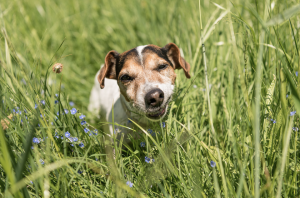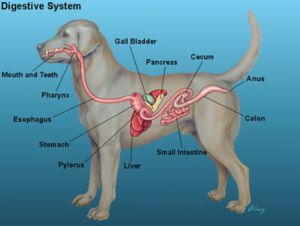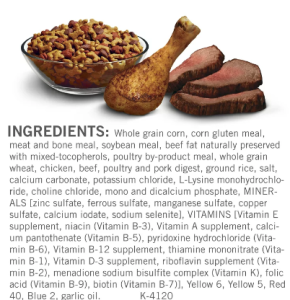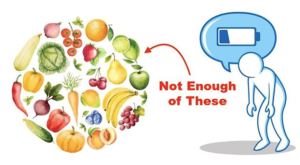71 Got Grass?
gorni024 and grady172
Got Grass?
Introduction
How many of you have heard that dogs eat grass to soothe their stomach? This is a common misconception that attempts to explain a much more complex topic. There are two fundamental reasons why a dog would eat grass both nutritional and psychological. This lesson will primarily cover the nutritional reasons behind this behavior, however just for kickers psychological reasons include boredom, loneliness, and anxiety.

Learning Objectives
- Identify & describe the major components of a dog’s GI tract.
- Identify the nutritional needs of dogs.
- Describe what a dietary deficiency is and how they affect dogs.
- Explain how the behavior of eating grass combats fiber deficiency in dogs.
Review Material
Gastrointestinal Tract
Similar to humans and cats, dogs have a simple gastrointestinal (GI) tract that is centered around a single true stomach. When a dog eats food travels down the esophagus into the stomach where it is broken down into tiny particles. From the stomach, these food particles travel into the small intestine where nutrients and water are absorbed into the body. Lastly, the remaining food components move into the large intestine (colon) where any residual water is removed to produce the waste products that will be excreted through the anus.

Nutritional Needs
As a reminder, there are three nutritional classifications: carnivore, omnivore and herbivore. Carnivores only need to eat meat to fulfill their nutritional needs. Omnivores need to eat plants and meat to satisfy their nutritional needs. Herbivores need to eat plants to achieve their nutritional needs. Dogs are classified as omnivores. As such, a healthy diet for dogs includes grains, meat, and plant products. This balance maintains a well functioning GI tract. When choosing a diet for your dog, it is important to read the ingredient list on the back of the bag to ensure these categories are met.

Dietary Deficiencies
As previously stated, dogs require a healthy balance of grains, meat, and plant products in their diet. While most dog food brands ensure that each of these requirements are met, some don’t. When a given nutritional requirement is not met, this is called a dietary deficiency. Dietary deficiencies can lead to many health problems, for example, low calcium levels in the diet can cause bone weakness. One dietary deficiency that specifically impacts dogs is a fiber deficiency. Common sources of fiber within a dog’s diet include pumpkin, apples, whole grains, leafy greens, grass, and carrots. This deficiency can lead to problems within the large intestine, especially the formation of stool. Examples of these consequences include constipation or watery stool.

So why do dogs eat grass? How does this relate to a fiber deficiency? Can you figure it out?!? Complete the activities below to check your knowledge.
Activities
Drag the correct label to the blank area to identify the different parts of a dog’s GI system
Knowledge Check
Test yourself! Complete this quick 5 question quiz on your own, without using any notes.
Resources
VCA Hospitals: Why Do Dogs Eat Grass

